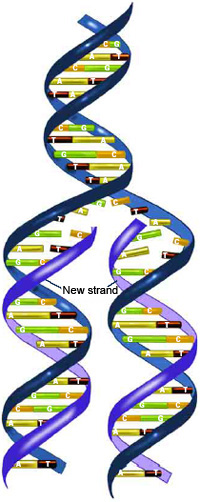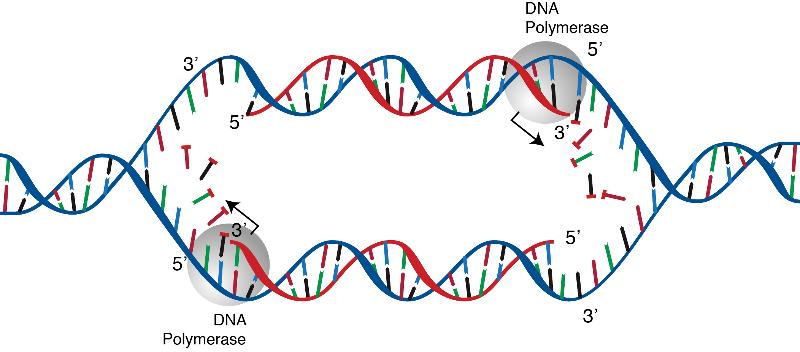DNA Replication
During DNA replication, each of the two strands of DNA serves as the template for the synthesis of a new, complementary strand.

Figure 5. This image represents a simplified model of DNA Replication. At the top, the parental DNA contains two strands of DNA with hydrogen bonds between complimentary bases. In the middle of the figure, the two parental DNA strands begin to separate in the first step of replication, leaving both strands available to act as templates for new DNA. At the bottom of the figure, complementary base pairs align with the templates and connect at the sugar-phosphate backbone to form new DNA molecules, each with a single old and new strand.
Watson and Crick hypothesized that DNA replication occurred when the double helix separated, and the two strands acted as templates for new strand synthesis, resulting in two double strands that each contains one old and one newly replicated strand. The model of DNA replication that Watson and Crick proposed is called the semiconservative model because it results in two daughter double helices that each contains one old strand and one newly replicated strand of DNA.
The following video explains DNA replication:
![]()
![]()
Video 3. Click this link to view DNA Replication - What is it? on YouTube (opens in new window).
In eukaryotes, DNA replication is controlled within the cell cycle as we discussed in the beginning of Unit 4. As the cell grows and divides, it progresses through stages. DNA replication occurs during the synthesis, or S phase. Most bacteria, or prokaryotes, do not go through a well-defined cell cycle, but instead continuously copy their DNA. During rapid growth, this can result in the concurrent occurrences of multiple rounds of replication.
DNA replication begins with the unzipping of the parent molecule as the hydrogen bonds between the base pairs are broken. The process is initiated at particular points in the DNA, known as origins, which are targeted by proteins that separate the two strands and initiate DNA synthesis. Origins of replication contain DNA sequences recognized by replication initiator proteins. These initiator proteins recruit other proteins to separate the two strands at the origin, forming a bubble. As DNA synthesis continues, the original DNA strands unwind on each side of the bubble, forming a replication fork with two prongs at each end of the bubble.

Figure 6. Summary of DNA Replication. In DNA Replication, the bonds are broken between the two strands of the DNA double helix, then the DNA is then unwound, and both sides of the double helix used as templates to build new strands of complementary DNA. The result is two new copies of the DNA, each one having an old and a new strand.
Self-assessment
Test your knowledge by completing the quiz below.



